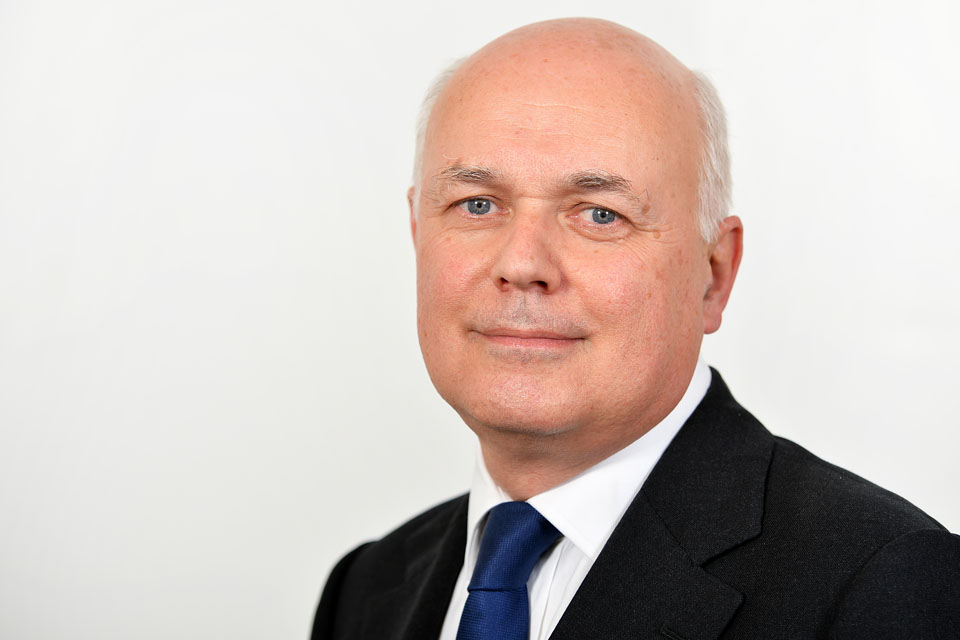Centre for Social Justice: early intervention
Speech by the Rt Hon Iain Duncan Smith MP.

Introduction
It’s good to see so many people here today engaging with this issue.
As the other speakers have made clear, the evidence on the importance of early intervention is now pretty overwhelming.
Frank Field’s report into life chances cited research showing that the simple fact of a parent being interested in their children’s education could increase the child’s chances of moving out of poverty as an adult by 25 percentage points.
And Graham Allen reminded us of the fact that a child’s development score at just 22 months can serve as an accurate predictor of educational outcomes at 26 years
Graham Allen’s report
This is an issue close to my heart.
Graham and I came together in 2008 - two politicians from different parties - to write a book which established the case for early intervention.
I saw first hand Graham’s passion for this issue, and so I had little hesitation in asking him to write two further reports on this for the Government.
Throughout these reports he has worked with local authorities, investors and voluntary and community organisations to put these issues high up on the public agenda.
Graham’s first report established the evidence base and some of the best practice around early intervention.
His second - published earlier this week - is about how we provide the means to make early intervention happen.
We will be looking carefully at the specific recommendations in the report, but the message coming through loud and clear is that social investment needs to be part of the solution, rewarding investors when their money yields savings to the public purse and delivers improvements in young people’s lives.
Not only does this make economic sense, it is also a question of social justice, getting investors to do something positive for their community while seeing a return on their investment at the same time.
The social investment market is still at an early stage but I believe it has real potential.
Just two days ago I spoke to a room of more than 300 prospective investors and delivery organisations who have expressed interest in bidding for the Government’s new Innovation Fund, which will reward investors for backing innovative projects which help disadvantaged young people.
And I like to think of this as just the start of a process.
Sir Ronald Cohen has spoken eloquently about the possibilities here, arguing that: “Social enterprise and impact investing…look like the wave of the future.”
He has even claimed that “Impact [social investment] capital is the new venture capital”.
These are bold statements, and it is still early days.
There is still a great deal of work that needs to be done, particularly around how we value the impact of private investments and translate that into clear and measurable returns.
But we are now very much on the right road.
Priority to the early years
At the same time there is an important role for Government to play, both at the central and the local level.
In a tight fiscal environment it is more important than ever that we get this right, which is why today’s report from the CSJ is helpful.
I just want to emphasise two important points from the report.
First, we need to remember the distinction between early intervention as a whole and the early, or foundation, years - in other words the years 0-5.
Both are important.
The early years are about creating a social and emotional bedrock, whereas the years up to 18 are about helping children become the excellent parents of tomorrow.
But it is clear that the early years are particularly critical.
Studies show that at birth only 25% of a child’s brain is formed. By the age of three, 80% is.
So it is important that we offer support to every child to reach their full capacity as early as possible.
Best practice
The second point I want to emphasise is around best practice.
Graham’s first report listed 19 programmes that were seen to represent the best in the field of early intervention.
But, as Graham himself made clear, this list was far from exhaustive, and it’s critical that local authorities don’t take this as the final word on what works in early intervention.
What works in Islington won’t necessarily be the same as what works in Ipswich.
And, as the CSJ report explains, there may be more to this than effectiveness alone.
There are also questions of what is feasible, and whether the intervention is appropriate for the recipient.
These are questions that local authorities need to be looking into carefully, not just relying on a list that was never intended solely as a blanket cover-all.
Conclusion
If we can move forward on this basis…
…building the social investment market…
…prioritising the early years…
…and continuing to look carefully at what really works…
…I think we will be in a position to make a powerful offer to some of the poorest families in our society, building a solid foundation for the future.
If we don’t, the next generation could be condemned to repeat the mistakes and problems of their parents.
We need to keep hammering home the message that early intervention offers the best hope for today’s children.
It could turn out to be the smartest decision local and national government ever made.